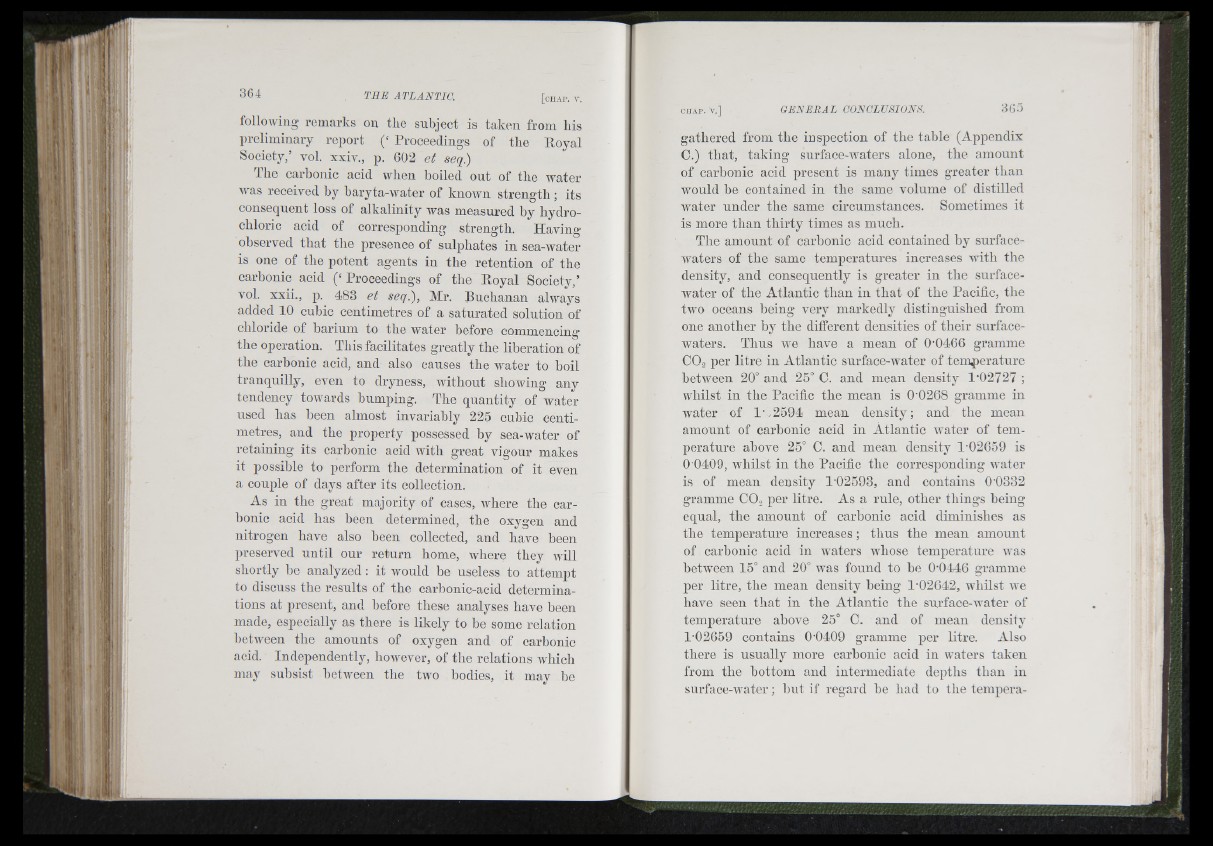
i ill
I l l ■
IF
i -t . .
■■il
1 Ml
following remarks on the subject is taken from bis
preliminary report (‘ Proceedings of tbe Royal
Society,’ vol. xxiv., p. 602 e t seq.)
Tbe carbonic acid when boiled out of tbe AA'ater
AV'as received by baryta-Avater of knoAvn strength ; its
consequent loss of alkalinity was measured by liydro-
cbloric acid of corresponding strength. Having-
observed tb a t tbe presence of sulphates in sea-water
is one of tbe potent agents in tbe retention of the
carbonic acid (‘ Proceedings of the Royal Society,’
vol. xxii., p. 483 e t s e q . ) , Mr. Bucbanan always
added 10 cubic centimetres of a saturated solution of
chloride of barium to tbe water before commencing
tbe operation. Tbis facilitates greatly tbe liberation of
tbe carbonic acid, and also causes tbe water to boil
tranquilly, even to dryness, Avithont showing any
tendency toAvards bumping. Tbe quantity of water
used has heen almost invariably 225 cubic centimetres,
and the property possessed by sea-Avater of
retaining its carbonic acid Avith great vigour makes
it possible to perform the determination of it even
a couple of days after its collection.
As in tbe great majority of cases, Avhere the carbonic
acid has heen determined, the oxygen and
nitrogen have also heen collected, and have been
preserved u ntil our return home, Avhere they aa'IU
shortly he analyzed; it would be useless to attempt
to discuss the results of tbe carbonic-acid determinations
at present, and before these analyses bave been
made, especially as tbere is likely to be some relation
between the amounts of oxygen and of carbonic
acid. Independently, boAvever, of tbe relations Avhicb
may subsist betAveen tbe two bodies, it may be
gathered from tbe inspection of the table (Appendix
C.) tbat, taking surface-waters alone, the amount
of carbonic acid present is many times greater than
would be contained in the same volume of distilled
water under the same circumstances. Sometimes it
is more than thirty times as much.
The amount of carbonic acid contained by surface-
Avaters of the same temperatures increases with the
density, and consequently is greater in the surface-
water of the Atlantic than in th a t of the Pacific, the
two oceans heing A'ery markedly distinguished from
one another by the diiferent densities of their surface-
waters. Thus Ave have a mean of 0-0466 gramme
CO2 per litre in Atlantic surface-water of temperature
between 20° and 25° C. and mean density 1-02727 ;
whilst in the Pacific the mean is 0 0268 gramme in
water of 1-.2594 mean density; and the mean
amount of carbonic acid in Atlantic Avater of temperature
ahove 25° C. and mean density 1-02659 is
0 0409, whilst in the Pacific the corresponding Avater
is of mean density 1-02593, and contains 0-0332
gramme CO2 per litre. As a rule, other things heing
equal, the amount of carbonic acid diminishes as
the temperature increases ; thus the mean amount
of carbonic acid in waters whose temperature was
hetAA'cen 15° and 20° Avas found to he 0-0446 gramme
per litre, the mean density being 1-02642, whilst aa'C
have seen th a t in the Atlantic the surface-water of
temperature aboA'e 25° C. and of mean density
1-02659 contains 0-0409 gramme per litre. Also
there is usually more carhouic acid in AA'aters taken
from the hottom and intermediate depths than in
surface-Avater ; but if regard be bad to tbe tempera